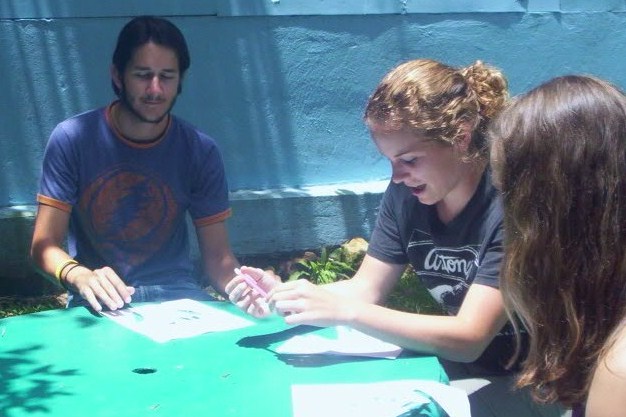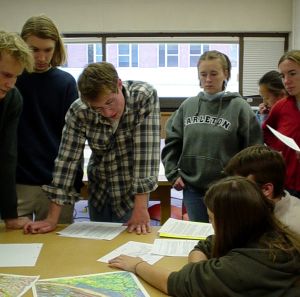This blog is about the Cooperative Learning Concept. The following information will be presented: The definition of cooperative learning. What is cooperative learning? Importance of cooperative learning. Usage and applications of cooperative learning. Advantages/Disadvantages of cooperative learning. Theories that incorporate cooperative learning and the authors of the theories.
Please take time to post a comment regarding the information on Cooperative Learning, answer the poll question, and visit the provided relevant hyperlink sources.
Tuesday, April 20, 2010
What is Cooperative Learning?
According to the University of Tennessee at Chattanooga (1998), "cooperative learning is a generic term for various small group interactive instructional procedures.” This learning concept allows small groups of students to work together to help themselves and their teammates to learn. Students may also be assigned to a group to work on long-term classroom goals. These groups are called base groups. "Base groups are cooperative groups that last the entire semester or school year; they provide a means through which students can clarify assignments for one another, help one another with class notes, and provide one another with a general sense of support and belonging in the classroom" (Ormrod, 2004, p. 413). Students work together on common tasks or learning activities that are best handled through group work. These are characteristics of cooperative learning:
When activities are designed and structured appropriately, cooperative learning can be very effective. According to Ormrod (2004), “students of all ability levels show higher academic achievement; females, members of minority groups, and students at risk for academic failure are especially likely to show increased achievement” (p. 417). This learning concept can promote advanced level of thinking skills:
Advantages / Disadvantages
There are many advantages to cooperative learning. According to Ormrod (2004), "Students have a higher self-efficacy about their chances of being successful, express more intrinsic motivation to learn school subject matter, participate more actively in classroom activities, and exhibit more self-regulated learning" (p. 417). This allows students to engage in prosocial behaviors, perspectives of others, divide task equally, resolve interpersonal conflicts, and provide encouragement and support to each other. Students will have an increased number of friendships with racial groups, ethnic groups, and persons with disabilities. Cooperative learning concepts provide an array of learning tasks and are preferred over competitive and individualized learning. A number of schools are adopting this style of classroom learning. Cooperative learning concept is effective and allows students to tutor each other on information being studied (North Central Regional Education Laboratory, 2004).
Disadvantages of cooperative learning are that “students may sometimes be more interested in achieving a group reward with the least possible effort and so will focus more on getting the “right” answer than on ensuring that all group members understand the subject matter being studied” (Ormrod, 2004, p. 417). If one student does more talking and work, that student has the tendency to learn more than the others in the group. If incorrect information, strategies, or methods are suggested by one student, then the whole group is at risk. It is important for the teacher to follow the group’s discussions and lesson plans. The teacher should provide structure and guidance to promote the utmost learning and achievement possibilities (Ormrod, 2004).
According to Ormrod (2004), “from a behaviorist of point view, rewards for groups success are consistent with the operant conditioning notion of a group contingency” (p. 413). Behaviorist learning is the permanent change in behavior due to experience and results in an external change that can be observed. B. F. Skinner created the idea of operant conditioning in 1938, but views evolved when he died in 1990. The following are examples of how these ideas evolved:
The social cognitive theorist point of view suggests that students are able to perform tasks with greater self-efficacy when they know they are helping other group members. Cognitive learning is when mental association permanently changes due to the experiences and results in an internal change which can not be observed. Alberta Bandura evolved behaviorism and cognitive theories. Social learning emphasizes the beliefs, attitudes, and behaviors. Self-regulation is incorporated in this theory, and its ability to maintain one’s own behavior with internalized standards (College of Saint Benedict Saint John’s University, 2009). In cooperative learning, the teacher would provide the stimulus for the group to promote self- instruction, self-motivation, self-reinforcement, and self-imposed stimulus control.
The contemporary cognitivist point of view suggests “students who collaborate on a learning task create scaffolding for one another’s efforts and may co-construct more sophisticated ideas and strategies than any single group member might be able to construct alone” (Ormrod, 2004, p. 413).
References
College of Saint Benedict Saint John’s University (2009). Program goal II: Student learning. Retrieved April
18, 2010, from http://www1.csbsju.edu/EDUCATion/knowledgebase/knowledgebaseii.htm
Ormrod, J. E. (2004). Human learning. (4th ed.). Upper Saddle River, NJ: Pearson Prentice Hall.
Institute for Dynamic Education Advancement (2010). Cooperative learning: Actively engaging students
work in collaboration. Retrieved April 15, 2010, from http://www.idea.org/page112.html
North Central Regional Educational Laboratory (2004). Cooperative Learning. Retrieved April 12, 2010,
from http://www.ncrel.org/sdrs/areas/issues/students/learning/lr1coop.htm
The University of Tennessee at Chattanooga (1998). Cooperative Learning. Retrieved April 12, 2010, from
http://www.utc.edu/Administration/WalkerTeachingResourceCenter/FacultyDevelopment/CooperativeLearning/
- Students work together in small groups containing two to five members.
- Students are positively interdependent.
- Activities are structured so that students need each other to accomplish their common tasks or learning activities.
- Students are individually accountable or responsible for their work or learning (University of Tennessee at Chattanooga, 1998).
Students work in small, teacher-assigned groups.
Groups have one or more common goal toward which to work.
Students are given clear guidelines about how to behave.
Group members depend on one another for their success.
A structure is provided to encourage productive learning behaviors.
The teacher serves primarily as a resource and monitor.
Students are individually accountable for their achievement.
Students are rewarded for group success.
At the completion of an activity, each group evaluates its effectiveness (Ormrod, 2004, p. 414-15).
When activities are designed and structured appropriately, cooperative learning can be very effective. According to Ormrod (2004), “students of all ability levels show higher academic achievement; females, members of minority groups, and students at risk for academic failure are especially likely to show increased achievement” (p. 417). This learning concept can promote advanced level of thinking skills:
- Students essentially think aloud.
Students are able model various learning and problem solving strategies for one another.
Students are able to develop a greater metacognitive awareness as a result.
Cooperative learning allows the teacher to actively involve students in discovering knowledge through a new learning process. The learning process takes place through dialogue among the students. Dialogue can be achieved through formulated questions, discussions, explanations, debates, writings, and brainstorming during class (Institute for Dynamic Educational Advancement (IDEA), 2010). Projects that require a wide range of talents and skills can be assigned to each group member, contributing to the group’s overall success (Ormrod, 2004, p. 417). Assigning different roles to different students and providing scripts for interaction is another application of cooperative learning.
Advantages / Disadvantages
There are many advantages to cooperative learning. According to Ormrod (2004), "Students have a higher self-efficacy about their chances of being successful, express more intrinsic motivation to learn school subject matter, participate more actively in classroom activities, and exhibit more self-regulated learning" (p. 417). This allows students to engage in prosocial behaviors, perspectives of others, divide task equally, resolve interpersonal conflicts, and provide encouragement and support to each other. Students will have an increased number of friendships with racial groups, ethnic groups, and persons with disabilities. Cooperative learning concepts provide an array of learning tasks and are preferred over competitive and individualized learning. A number of schools are adopting this style of classroom learning. Cooperative learning concept is effective and allows students to tutor each other on information being studied (North Central Regional Education Laboratory, 2004).
Disadvantages of cooperative learning are that “students may sometimes be more interested in achieving a group reward with the least possible effort and so will focus more on getting the “right” answer than on ensuring that all group members understand the subject matter being studied” (Ormrod, 2004, p. 417). If one student does more talking and work, that student has the tendency to learn more than the others in the group. If incorrect information, strategies, or methods are suggested by one student, then the whole group is at risk. It is important for the teacher to follow the group’s discussions and lesson plans. The teacher should provide structure and guidance to promote the utmost learning and achievement possibilities (Ormrod, 2004).
Theories That Incorporate Cooperative Learning and the Authors of the Theories
According to Ormrod (2004), “from a behaviorist of point view, rewards for groups success are consistent with the operant conditioning notion of a group contingency” (p. 413). Behaviorist learning is the permanent change in behavior due to experience and results in an external change that can be observed. B. F. Skinner created the idea of operant conditioning in 1938, but views evolved when he died in 1990. The following are examples of how these ideas evolved:
- Behavior is better understood by looking at a larger context and longer time frame than has traditionally been the case.
- Operant conditioning involves cognition as well as behavior.
- Operant and classical conditioning, taken together, do not completely determine the behaviors that an organism will exhibit on any given occasion.
- Just as reinforcement increases the frequency of a response, punishment can be an effective means of decreasing a response (Ormrod, 2004, p. 73-4).
The social cognitive theorist point of view suggests that students are able to perform tasks with greater self-efficacy when they know they are helping other group members. Cognitive learning is when mental association permanently changes due to the experiences and results in an internal change which can not be observed. Alberta Bandura evolved behaviorism and cognitive theories. Social learning emphasizes the beliefs, attitudes, and behaviors. Self-regulation is incorporated in this theory, and its ability to maintain one’s own behavior with internalized standards (College of Saint Benedict Saint John’s University, 2009). In cooperative learning, the teacher would provide the stimulus for the group to promote self- instruction, self-motivation, self-reinforcement, and self-imposed stimulus control.
The contemporary cognitivist point of view suggests “students who collaborate on a learning task create scaffolding for one another’s efforts and may co-construct more sophisticated ideas and strategies than any single group member might be able to construct alone” (Ormrod, 2004, p. 413).
References
18, 2010, from http://www1.csbsju.edu/EDUCATion/knowledgebase/knowledgebaseii.htm
Ormrod, J. E. (2004). Human learning. (4th ed.). Upper Saddle River, NJ: Pearson Prentice Hall.
Institute for Dynamic Education Advancement (2010). Cooperative learning: Actively engaging students
work in collaboration. Retrieved April 15, 2010, from http://www.idea.org/page112.html
North Central Regional Educational Laboratory (2004). Cooperative Learning. Retrieved April 12, 2010,
from http://www.ncrel.org/sdrs/areas/issues/students/learning/lr1coop.htm
The University of Tennessee at Chattanooga (1998). Cooperative Learning. Retrieved April 12, 2010, from
http://www.utc.edu/Administration/WalkerTeachingResourceCenter/FacultyDevelopment/CooperativeLearning/
Subscribe to:
Comments (Atom)








